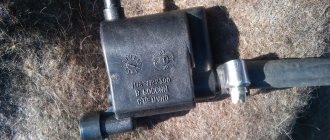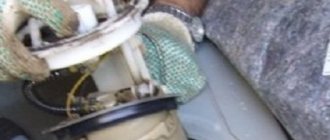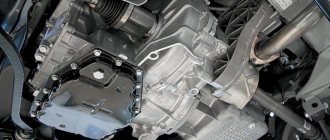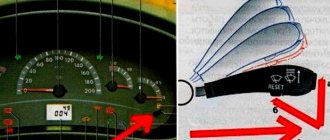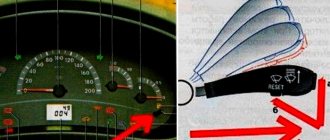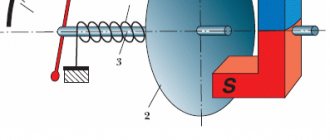The gas tank of any car always contains vapors formed due to a decrease in atmospheric pressure or heating of the fuel. In order to prevent the leakage of fuel vapors into the vehicle, a special gasoline vapor recovery system (VPSU) is installed. Thanks to it, the vapors retained by the adsorber (essentially activated carbon) enter the intake manifold and burn in the engine cylinders. To regulate the amount of gasoline vapor coming from the adsorber to the manifold, a special solenoid valve is used.
Why do you need a gasoline vapor recovery system?
Injection vehicles (including Kalina), whose environmental class belongs to Euro-3, must be equipped with an EPS. This prevents fuel vapors from entering the atmosphere, polluting it. In addition, the system guarantees more stable operation of the power plant and saves gasoline. How to check the adsorber valve included in the SUBS and how it functions will be discussed further.
How to remove fuel vapor recovery elements Lada Kalina
If it is necessary to remove the adsorber, you must first remove the fuel tank, as shown in the article - “Removing the tank”.
But you can remove the adsorber if you lower the tank a little on an adjustable stand
In this case, you do not need to disconnect all the tubes from the tank, and most importantly the filler pipe hose. But there will still be difficulties when dismantling the adsorber.
For greater clarity, let's consider dismantling with the fuel tank removed.
We remove the tube connecting the adsorber to the purge solenoid valve from two metal holders.
Using a 10mm socket, unscrew the nut of the canister fastening clamp and remove the clamp, removing its other end from the clamp in the tank.
Using one screwdriver, press the bracket latch and use another screwdriver to lift the adsorber.
Removing the adsorber
Install the adsorber in reverse order.
Removing the separator
To make it easier to remove the separator, remove the right rear wheel.
Disconnect the tip of the fuel vapor removal tube from the separator from the tube located on the tank.
Using a 10mm socket, unscrew the two nuts securing the plastic holders of the fuel vapor removal tube from the separator to the rear wheel arch.
Remove the holders from the studs
Using a 10mm wrench, unscrew the bolt and nut securing the plastic holders of the fuel vapor removal tube from the separator to the right rear side member, and remove the holders
Using a Phillips screwdriver, loosen the clamp securing the fuel vapor supply hose from the fuel tank to the separator.
Using a 13 mm wrench, unscrew the three separator mounting nuts and remove the hose from the separator fitting
Remove the separator assembly with gravity valve and fuel vapor exhaust pipe
To remove the gravity valve with a tube, use a screwdriver to pry up the valve flange
Remove the valve from the separator hole
Remove the rubber o-ring
We assemble and install the separator in the reverse order.
Replacing the canister purge solenoid valve
To dismantle the canister purge solenoid valve, remove the mass air flow sensor (article - “Removing the mass air flow sensor”) or remove the cover of the air filter housing and move it to the side together with the air supply hose to the throttle assembly (article - “Replacing the replacement air filter element ").
Having released the clamp of the wire block of the solenoid valve for purge of the adsorber, disconnect the block from the valve.
Remove the valve from the bracket on the air filter housing.
By pressing the latch of the tip of the fuel vapor supply tube, remove the tip of the tube from the valve fitting.
Using a Phillips screwdriver, loosen the clamp securing the fuel vapor supply hose from the valve to the throttle assembly, remove the hose from the throttle assembly fitting and remove the solenoid valve.
We install the solenoid valve for purge the adsorber in the reverse order.
Principle of operation
The adsorber itself allows fuel vapors to accumulate in a special place - the separator. As a result, gasoline turns into condensate and goes back to the tank. Vapors that have not undergone treatment go through double valves of the system, one of which prevents fuel from spilling out during an emergency (for example, a coup), and the second “is engaged” in regulating the pressure in the tank. The adsorber purge valve is located under the hood, and the adsorber itself is located on the tank. The control unit ensures the normal operation of the entire system: it ventilates and removes condensation.
Purpose of the adsorber purge valve
In the Lada Kalina model, as in principle in any other car equipped with distributed fuel injection, an adsorbing system is necessary to localize the resulting gasoline vapors. They accumulate inside the tank after the engine stops, and after a certain time necessary for the transformation of these vapors into a condensation state, they turn back into liquid fuel. The remaining volume of vapor that failed to return to the tank moves to the adsorber, where it is retained by two valves. The first (gravity type) is necessary to prevent fuel spillage when the LADA Kalina body turns over (in an accident, etc.), and with the help of the 2nd, the pressure indicator inside the tank is monitored.
Having overcome these valves, the vapors move into the cavity of the adsorber, which is made in the form of a can filled with activated carbon. Immediately after starting the engine, the vapors accumulated inside the tank are sent to chambers where they are burned.
To ensure that the circuit of this unit is ventilated and has the ability to regulate the volume of vapors, the adsorber contains an electromechanical adsorber purge valve for purge (KPA). The adsorber sensor is controlled by a special controller.
If a malfunction occurs in this unit, the LADA Kalina engine immediately reacts to this by increasing fuel consumption and reducing power. Also, if the adsorber sensor does not work correctly, this can cause unsatisfactory ventilation of the tank or even damage the fuel pump.
How to check the operation of the sensor? To diagnose the system, you need to take into account a few simple signs. A malfunction of the adsorber can reveal itself as engine failure at idle speed, in addition to which there is a presence of fuel smell inside the Lada Kalina’s cabin. It is in this case that it will be necessary to immediately replace the control unit, otherwise there is a risk of significant damage to the engine components and elements of the fuel supply circuit. Now you know how to check the system.
Design and operation of the adsorber purge valve
The KPA is an electromagnetic locking device that operates from the vehicle’s on-board network. The valve consists of:
- plastic case;
- valve with spring;
- windings;
- metal core;
- connector
When the vehicle's engine is turned off, no voltage is supplied to the valve and it remains in the closed position. That is, on the motor side, the system that captures vapors is blocked. At the same time, the adsorber begins to “collect” vapors. When the power unit starts, voltage is applied to the valve, causing it to open and fuel vapors to enter the intake manifold. As soon as the ignition is turned off, the control unit is de-energized and the pipeline is closed: no vapors enter the receiver.
Cars of a high price category have a more complex evaporation system. Such machines have special sensors that can “calculate” the amount of air and vapor as a percentage. This allows you to more accurately control the supply of gasoline to the injector.
How does the Lada Kalina gasoline vapor recovery system work?
The EVAP system in question was created to prevent the release of harmful gasoline vapors into the surrounding atmosphere resulting from fuel evaporation; it includes:
- fuel shut-off valve;
- adsorber;
- solenoid valve for purging the absorbent element;
- connecting pipelines.
The most important component in the system is the adsorber (also called a carbon filter), the basis of which is activated non-edible carbon, enclosed in a plastic housing. The resulting gasoline vapors are absorbed by the carbon of the absorbent element, gradually accumulating in it. When the engine starts, the canister purge valve (KPA) is turned on, and due to the vacuum, all accumulated vapors enter the intake manifold and then burn out.
On the Lada Kalina, the adsorber is located in the gas tank area, and getting to it is very difficult. To dismantle this EVAP element, it is necessary to remove the fuel tank, but the control unit is located in an accessible place - the valve is located in the engine compartment, in close proximity to the battery, on the rear wall of the air filter housing. It should be noted that for turbocharged engines, a vacuum is not created in the intake manifold, and in order to force the vapors in the desired direction, an additional two-way valve is included in the circuit.
Signs of a malfunction of the control unit
First, start the engine: at idle or in cold weather, you will hear a characteristic, barely audible chirping sound. It indicates that the valve is working properly. In order not to confuse this sound with the noise from a working timing belt, sharply press the gas. The character of the chatter should not change. The following signs indicate a malfunction of the control unit:
- lighting of the CHECK signal on the instrument panel;
- determination of error PO441 during testing;
- increased gasoline consumption;
- unstable operation of the power unit when driving;
- unstable idle;
- increase in CO2 content;
- a hissing sound when unscrewing the tank lid (a vacuum has appeared);
- the appearance of a fuel smell in the cabin.
Valve check on site
You will need a tester (voltmeter, multimeter) and a screwdriver. The KPA itself is installed on the radiator frame. The device can be recognized by seeing two tubes approaching it, through which the evaporation moves. Further:
- disconnect the electrical connector from the control unit by releasing the block lock;
- using a multimeter, check for the presence of voltage by touching the negative (black) probe of the device to ground, and the red probe to “A” (the letter on the block connector);
- turn on the ignition: the multimeter should show the vehicle's on-board voltage. If not, check the wiring.
What is the correct name for an adsorber or absorber?
Both concepts exist in the world. But despite the fact that from the Latin “sorbeo” and “absorbeo” are translated almost identically: adsorber - (from Latin ad - on, with and sorbeo - absorb), and absorber - (from Latin absorbeo - absorb), the semantic load both words convey different meanings.
- In our case, we are talking specifically about an adsorber, since this is a device that, with its solid surface, absorbs gaseous or soluble substances without undergoing chemical reactions. There are periodic and continuous devices.
- And an absorber is a device that completely absorbs gases (vapors) inside, followed by a chemical reaction, as a result of which one of the substances is completely absorbed by a special liquid (absorber).
Therefore, for our situation, the first option will be correct.
How to remove the purge valve
Remove the negative terminal from the battery. If the mass air flow sensor (mass air flow sensor) interferes, remove the inlet pipe from it. Then bend the valve mount and pull it up. Now you need to disconnect a couple of fittings. The first one can be removed freely; to pull out the second one, press the latch and pry up the antennae, for example, with a thin screwdriver.
Dismantling the adsorber Lada Granta VAZ 2190
Due to the design features of the Lada Grant, access to the adsorber is difficult. First we perform the following steps:
- We remove the fuel tank from the bottom of the car, unscrew the six bolts around the perimeter, and disconnect the block with wires from the fuel pump.
- Disconnect the canister vent pipe and press the lock.
Disconnect the pipe
- We remove the adsorber, remove it from the retainer, replace it with a new one, and assemble the parts in the reverse order.
Removing the adsorber
